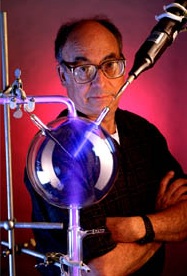Stanley Miller
Stanley Lloyd Miller | |
|---|---|
 | |
| Born | March 7, 1930 |
| Died | May 20, 2007 (age 77) |
| Nationality | American |
| Known for | Origin of Life |
| Scientific career | |
| Fields | Chemistry |
| Institutions | University of Chicago |
| Doctoral advisor | Harold Urey |
Stanley Lloyd Miller (March 7, 1930 - May 20, 2007) was an American chemist and biologist who is known for his studies into the origin of life, particularly the Miller-Urey experiment which demonstrated that organic compounds can be created by fairly simple physical processes from inorganic substances. The experiment used conditions then thought to provide an approximate representation of those present on the primordial Earth.
Life and career
Born in Oakland, California, he studied at University of California at Berkeley (earning his B.S. in 1951) and then at University of Chicago where he earned his Ph.D. in chemistry in 1954. While at Chicago, Miller was a student of Harold Urey. [1]
Miller continued his research at California Institute of Technology (1954-1955) and then joined the department of biochemistry at Columbia University, New York where he worked for the next five years. He then returned to California where he was an assistant professor (1960-1962), associate professor (1962-1968), then full professor of chemistry at University of California at San Diego (from 1968).
His work dealt with the origin of life (and he was considered a pioneer in the field of exobiology), the natural occurrence of clathrate hydrates, and general mechanisms of anesthesia. He was a member of the National Academy of Science, and received the Oparin Medal. He was a participant in the pioneering Miller-Urey experiment. In the 1950s, Urey guessed that the early atmosphere of the Earth was probably like the atmosphere now present on Jupiter --i.e., rich in ammonia, methane, and hydrogen. Miller, working in his laboratory at the University of Chicago, demonstrated that when exposed to an energy source such as ultraviolet radiation, these compounds and water can react to produce amino acids essential for the formation of living matter. (Similar ideas had been suggested by Aleksandr Oparin in the 1920s.) Since then there have been objections that the early environment was possibly not as reducing as Miller and Urey assumed and Miller acknowledged this.[2]
In 2008, researchers found the apparatus that Miller used in his early experiments and analyzed the material using more sensitive later techniques. The experiments included previously unreported simulations of other environments, such as gases released in volcanic eruptions. The later analysis turned up many more amino acids and other compounds of interest.[3]
In 1828 Friedrich Wohler had showed that it is possible to synthesize urea. As urea is an organic molecule, many at the time thought it could only be made by living organisms. This led to recognition that there is no obvious difference between a physically produced and an organically produced molecule. Miller's experiment went slightly further by showing that basic biomolecules can be formed through simple physical processes, and that it was not impossible for the first stages of abiogenesis to have occurred on the early earth.
References
- ^ Wade, Nicolas (May 23, 2007). "Stanley Miller, Who Examined Origins of Life, Dies at 77", The New York Times.
- ^ "Stanley Lloyd Miller." Notable Scientists: From 1900 to the Present. Gale Group, 2001.
- ^ Johnson AP, Cleaves HJ, Dworkin JP, Glavin DP, Lazcano A, Bada JL (2008). "The Miller Volcanic Spark Discharge Experiment". Science. 322 (5900): 404. doi:10.1126/science.1161527.
{{cite journal}}: CS1 maint: multiple names: authors list (link)
